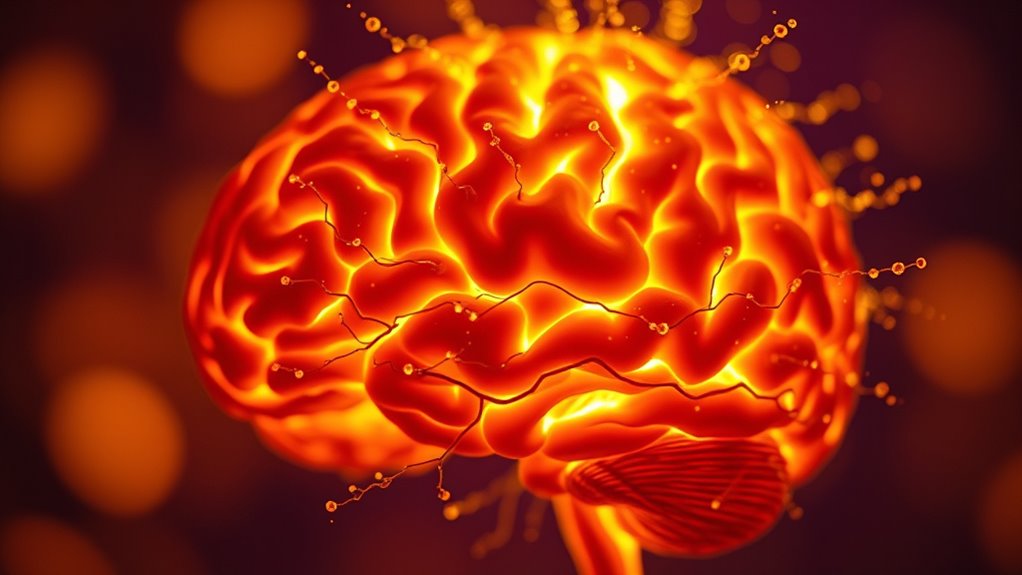Mindfulness & Well‑Being
Emotional Agility: Moving Through Difficult Feelings Effectively
Keen insight into emotional agility reveals how to navigate tough feelings; discover the key to resilience and emotional balance—continue reading to learn more.

To move through difficult feelings effectively, you need to develop emotional agility by recognizing and accepting your emotions with compassion. Practice mindfulness to stay present and observe your feelings without judgment, which helps you respond thoughtfully instead of reacting impulsively. Differentiating your emotions gives you clarity, allowing you to understand what they reveal about your needs. By cultivating this skill, you’ll build resilience and balance, empowering you to navigate challenges more confidently—continue exploring to uncover how you can strengthen this essential ability.
Key Takeaways
- Recognize and label emotions accurately to understand and navigate difficult feelings effectively.
- Practice mindfulness to stay present and non-judgmentally observe emotions without becoming overwhelmed.
- Accept emotions as natural, allowing space for feelings without suppression or avoidance.
- Respond thoughtfully based on values rather than impulsive reactions, fostering resilience.
- Develop ongoing emotional awareness and compassion to build long-term emotional agility and well-being.

Emotional agility is the ability to recognize, accept, and navigate your feelings with flexibility and resilience. It’s about staying connected to your emotions without becoming overwhelmed or disconnected, allowing you to respond thoughtfully rather than react impulsively. Developing emotional agility empowers you to handle life’s challenges more effectively, especially during difficult times. A key part of this process involves practicing mindfulness, which helps you stay present and aware of your emotional landscape without judgment. When you engage in mindfulness practices like meditation, deep breathing, or focused observation, you cultivate a calm, centered state that makes it easier to face uncomfortable feelings. This awareness strengthens your emotional resilience—the capacity to bounce back from setbacks or stressors. The more you practice mindfulness, the better you become at acknowledging your emotions without suppression or avoidance, creating a solid foundation for emotional agility.
As you become more skilled at recognizing your emotions in real-time, you’ll notice that you can better differentiate between what you’re feeling and how you choose to respond. This awareness grants you the power to step back, assess the situation objectively, and decide on a course of action aligned with your values rather than knee-jerk reactions. When faced with difficult feelings like anger, sadness, or frustration, instead of ignoring or suppressing them, you accept their presence. Acceptance doesn’t mean resignation but rather acknowledging the emotion as a natural part of the human experience. Once accepted, you can explore what the emotion is telling you about your needs or boundaries. This process fosters emotional resilience because it builds your capacity to endure discomfort without losing your equilibrium.
Practicing mindfulness also helps you develop a compassionate stance toward yourself, reducing self-criticism during tough times. When you approach your feelings with kindness, you create a safe internal environment that encourages growth and understanding. Over time, this approach strengthens your emotional agility, making it easier to move through difficult feelings without getting stuck or overwhelmed. You learn to observe your emotions objectively, allowing you to respond in ways that serve your well-being rather than reacting from a place of fear or impulsivity. Emotional agility, supported by consistent mindfulness practices, ultimately gives you more control over your emotional responses, leading to a more balanced, resilient, and fulfilling life.
Additionally, cultivating emotional regulation skills can further enhance your ability to manage intense feelings and maintain your mental health during stressful periods.
Frequently Asked Questions
How Can Emotional Agility Improve Workplace Productivity?
Improving workplace productivity starts with strengthening your emotional agility. By managing difficult feelings effectively, you boost your emotional intelligence, which enhances communication and collaboration. This resilience helps you adapt to change, reduce stress, and stay focused on goals. As a result, you create a positive environment where team members feel supported, leading to increased productivity and overall workplace resilience. Your ability to navigate emotions directly impacts your team’s success and efficiency.
What Are Common Barriers to Practicing Emotional Agility?
You might find emotional agility challenging because of common barriers like emotional avoidance and fear of vulnerability. When you avoid difficult feelings, it becomes harder to process them, leading to stagnation. Fear of vulnerability can make you hesitant to express emotions or admit struggles, blocking growth. These barriers prevent you from embracing your emotions fully, making it tougher to navigate tough situations with resilience. Overcoming these hurdles enables better emotional agility and personal growth.
Can Emotional Agility Help With Long-Term Mental Health?
You might wonder if emotional agility can support long-term mental health. It definitely can, as it enhances your emotional resilience and self-awareness. By learning to navigate difficult feelings without avoiding or overreacting, you build a stronger mental foundation. This ongoing practice helps you adapt better to life’s challenges, reduces stress, and promotes overall well-being, making emotional agility a valuable tool for sustained mental health.
How Does Emotional Agility Differ From Emotional Suppression?
When you ask how emotional agility differs from emotional suppression, you’re highlighting two ways to handle feelings. Emotional agility involves emotional awareness and acceptance, allowing you to experience emotions without being overwhelmed. It builds emotional resilience, helping you navigate tough situations. In contrast, emotional suppression forces you to hide or ignore feelings, which can harm your mental health over time. You choose emotional agility to stay balanced and resilient.
Are There Specific Techniques to Develop Emotional Agility?
Your mind is a battlefield, and developing emotional agility is the ultimate weapon. To do this, you can practice mindfulness regularly, helping you stay present and aware of your feelings without judgment. Cognitive reframing is also key, allowing you to shift negative thoughts into positive or neutral perspectives. These techniques strengthen your emotional resilience, enabling you to navigate tough emotions confidently and move through challenges with grace and ease.
Conclusion
By practicing emotional agility, you can navigate life’s ups and downs with resilience. Studies show that people who actively manage their emotions are 30% more likely to experience greater well-being and success. So, next time you face a tough feeling, remember it’s an opportunity to grow, not a obstacle. Embrace your emotions, move through them intentionally, and you’ll find yourself more adaptable and resilient in every challenge. Your emotional journey starts now—are you ready?
Mindfulness & Well‑Being
Office Mindfulness: Quiet Practices You Can Do at Your Desk
Mindfulness at your desk can transform stress into calm, but discovering the quiet practices that work best for you can unlock lasting focus and peace.

To boost focus and reduce stress at your desk, try simple mindfulness practices like breathing exercises and brief meditation pauses. Sit comfortably, take slow deep breaths through your nose, hold briefly, then exhale gently. Focus on your breath or bodily sensations, noting thoughts without judgment. Even a few minutes of this can clear your mind and promote calm throughout your day. Exploring more techniques can help you create a peaceful, productive workspace—discover how further inside.
Key Takeaways
- Practice quick breathing exercises, like deep inhales and gentle exhales, to reduce stress and improve focus at your desk.
- Incorporate brief desk meditation sessions by observing breath or bodily sensations without judgment.
- Use visualization techniques during exhalation to release tension and promote calmness throughout your workday.
- Maintain a regular routine of short mindfulness practices to enhance mental clarity and emotional resilience.
- Focus on consistency; even brief, quiet pauses can break stress cycles and boost overall well-being during office hours.

Have you ever wondered how a moment of calm can transform your busy workday? In the midst of deadlines and meetings, taking a brief pause can make all the difference. One simple way to introduce calm into your routine is through breathing exercises. These can be done right at your desk and require nothing more than a few focused breaths. Just sit comfortably, close your eyes if you like, and take a slow, deep inhale through your nose. Hold it for a count of three, then exhale gently through your mouth. Repeat this for a few cycles, paying close attention to the sensation of your breath. This practice helps reduce stress hormones, clears your mind, and improves your focus. Breathing exercises are quick, portable, and effective, making them perfect for busy professionals.
Another effective quiet practice you can incorporate is desk meditation. Unlike traditional meditation, which might seem time-consuming or requiring special space, desk meditation involves a brief, mindful pause at your workspace. To start, sit upright with your feet flat on the ground and your hands resting comfortably. Close your eyes or soften your gaze, and bring your attention to your breath or the sensations in your body. Focus on the present moment, observing thoughts or distractions without judgment. If your mind wanders, gently redirect it back to your breath or bodily sensations. Even just a minute or two of desk meditation can help break the cycle of stress and mental clutter that often accumulates during the day.
You can also combine breathing exercises with desk meditation for a more integrated approach. For example, take a deep breath, hold it briefly, then exhale slowly while visualizing releasing tension. Repeat this cycle a few times, consciously relaxing your muscles as you breathe out. This combination enhances your awareness, centers your thoughts, and fosters a sense of calm amid your busy schedule. The key is consistency, as even short, daily sessions can markedly boost your mental clarity and emotional resilience over time.
Frequently Asked Questions
Can Mindfulness Improve Productivity at Work?
Mindfulness benefits your work focus by helping you stay present and reduce distractions. When you practice mindfulness, you become more aware of your thoughts and emotions, allowing you to manage stress better. This clarity boosts your productivity, enabling you to complete tasks efficiently. Incorporating simple mindful habits into your day can transform your work routine, making you more focused, calm, and effective in achieving your professional goals.
How Long Should Office Mindfulness Sessions Last?
Research shows that even brief mindfulness sessions can boost focus and reduce stress. When considering mindfulness duration, aim for sessions of 5 to 10 minutes; this is often enough to reap benefits without disrupting your workflow. Keep session length manageable, and gradually extend it if you find it helpful. Short, consistent mindfulness practices fit well into a busy workday and enhance overall well-being.
Are There Apps to Guide Desk Mindfulness Exercises?
Yes, there are apps that guide desk mindfulness exercises. You can find apps offering guided meditation and breathing exercises, perfect for quick stress relief. These apps help you stay focused and calm during busy workdays, making it easier to integrate mindfulness into your routine. Try apps like Headspace, Calm, or Insight Timer—they provide step-by-step guidance for effective breathing exercises and meditation sessions right at your desk.
Is Mindfulness Suitable for High-Stress Work Environments?
You might wonder if mindfulness suits high-stress workplaces. Many believe mindfulness is just about relaxing, but misconceptions exist. It actually helps reduce workplace stress by increasing focus and emotional resilience. You can practice simple techniques at your desk, making it practical for busy environments. So, yes, mindfulness is suitable—it can improve your well-being and productivity, even in high-pressure settings. Just start with small, consistent steps to see its benefits.
Can Mindfulness Help Reduce Workplace Conflicts?
Mindfulness can definitely help reduce workplace conflicts by improving interpersonal harmony. When you practice mindfulness, you become more aware of your emotions and reactions, which aids in conflict resolution. This awareness helps you respond calmly and thoughtfully rather than impulsively. As a result, you foster a more collaborative environment, resolve misunderstandings more effectively, and create a more harmonious workplace where conflicts are minimized and relationships are strengthened.
Conclusion
By practicing these simple mindfulness techniques at your desk, you’ll transform your workspace into a sanctuary of calm amidst chaos. Imagine turning your cluttered desk into a peaceful oasis, where stress melts away like ice cream in the sun. With just a few quiet moments, you’ll feel more centered than a mountain peak and more focused than a laser beam. Embrace these practices, and watch your workday become a serene, unstoppable wave of clarity and calm.
Mindfulness & Well‑Being
Breathwork vs. Meditation: Which Is Right for You?
Not sure whether breathwork or meditation suits your needs best? Discover their differences to find your ideal practice.

If you’re looking for quick stress relief and mental clarity, breathwork may suit you best since it offers immediate physical and emotional effects through active breathing techniques. If you want ongoing inner growth, emotional balance, and resilience, meditation can provide long-term benefits with regular practice. Consider your preferences: do you want rapid results or a gradual, deeper journey? Exploring the differences can help you choose the practice that aligns with your goals—and there’s more to discover ahead.
Key Takeaways
- Breathwork offers quick mental clarity and stress relief through active breathing techniques, while meditation promotes long-term emotional resilience and mindfulness.
- Choose breathwork for immediate energy or relaxation needs; select meditation for sustained inner growth and emotional balance.
- Breathwork is more dynamic and easier to incorporate into busy schedules; meditation requires consistency for lasting benefits.
- Combining both methods can optimize mental clarity, stress reduction, and emotional well-being.
- Your choice depends on whether you seek quick relief or gradual, deep inner development.

When it comes to enhancing mental clarity and reducing stress, both breathwork and meditation offer powerful techniques, but they differ in approach and experience. Your journey to find the best method depends on understanding these differences and what resonates with you. Breathwork techniques involve actively manipulating your breathing patterns to influence your mental and physical state. This could mean practicing rapid, rhythmic breaths to energize yourself or slow, deep breaths to calm your nerves. Breathwork is often more dynamic and immediate, providing a sense of release and clarity quickly. Different breathwork techniques, such as box breathing, diaphragmatic breathing, or circular breathing, focus on controlling your breath to achieve specific outcomes like relaxation, focus, or emotional release.
Breathwork actively alters your breathing to quickly boost clarity and reduce stress.
On the other hand, meditation styles tend to be more passive and centered on cultivating awareness or mindfulness. You might sit quietly, focusing on your breath, a mantra, or simply observing your thoughts without attachment. Meditation styles vary widely—from guided meditation that directs your attention to specific themes, to transcendental meditation that uses specific mantras, to mindfulness meditation that emphasizes staying present. Unlike breathwork, which often involves physical techniques, meditation encourages an inward focus, fostering a sense of stillness and insight over time. While breathwork can generate immediate effects, meditation tends to build benefits gradually through consistent practice.
Choosing between breathwork and meditation depends on your personal preferences and goals. If you seek quick relief from stress or want to energize yourself during the day, breathwork techniques might suit you better. They’re often more engaging and can be incorporated easily into a busy schedule. Conversely, if you’re looking to develop long-term mental resilience, emotional balance, or heightened awareness, exploring different meditation styles could be more beneficial. Meditation encourages patience and persistence, helping you cultivate a deeper connection with your inner self.
Both methods have their unique strengths, and many people find combining them to be especially effective. You might start with breathwork to quickly de-stress and then transition into a meditation session to deepen your focus. Ultimately, the best approach is the one that feels sustainable and meaningful for you. Experiment with various breathwork techniques and meditation styles to discover what brings you clarity, calmness, and a sense of well-being. Remember, consistency is key—whether you prefer the active engagement of breathwork or the tranquil focus of meditation, regular practice will open their full benefits.
Frequently Asked Questions
Can Breathwork Replace Meditation Entirely?
You wonder if breathwork can replace meditation entirely. While breathwork enhances mindfulness and improves emotional regulation, it might not fully substitute meditation’s benefits like deep relaxation and mental clarity. Breathwork can be a powerful tool for immediate stress relief, but combining it with meditation offers a more holistic approach to emotional well-being. Ultimately, choosing depends on your personal goals, as both practices support mindfulness enhancement and emotional regulation uniquely.
How Long Should I Practice Each Regularly?
You should aim for a consistent practice schedule, focusing on breath duration that feels comfortable. Start with 5-10 minutes daily, gradually increasing as you become more comfortable. Practice consistency matters more than length, so set aside a specific time each day. Whether you practice breathwork or meditation, regular sessions help deepen your experience and maximize benefits. Listen to your body, and adapt your routine to fit your lifestyle.
Are There Any Risks Involved With Breathwork?
Did you know that improper breathwork can cause dizziness or hyperventilation in some people? While breathwork offers health benefits and aids emotional regulation, risks exist if you push too hard or have underlying health issues. Always practice in a safe environment, listen to your body, and consult a healthcare professional if you’re uncertain. With proper guidance, breathwork can enhance your well-being without unnecessary risks.
Which Method Is More Suitable for Beginners?
If you’re new to mindfulness practices, breathing techniques are a great starting point because they’re simple and help improve mental clarity. Breathwork often involves specific exercises that are easy to learn and can be done anywhere. Meditation may require more patience and focus initially. You should try both to see which feels more comfortable, but breathing techniques are typically more suitable for beginners due to their straightforward approach.
Can Both Practices Be Combined Effectively?
You can definitely combine breathwork and meditation for a more holistic wellness approach. Many integrative approaches embrace blending practices to enhance mental clarity and emotional balance. By incorporating both, you create a personalized routine that taps into the strengths of each method. This synergy supports your overall well-being, helping you relax, focus, and cultivate mindfulness more effectively. So, feel free to experiment and find what works best for your unique wellness journey.
Conclusion
Ultimately, choosing between breathwork and meditation depends on what resonates with you. If you’re looking for quick stress relief and a way to clear your mind, breathwork might be your best bet. However, if you want deeper inner peace and self-awareness, meditation could be the way to go. Remember, it’s all about finding what clicks; after all, you don’t want to put all your eggs in one basket. Try both and see what feels right!
Mindfulness & Well‑Being
How Gratitude Physically Transforms the Brain

Practicing gratitude rewires your brain by strengthening neural pathways linked to positive emotions, leading to lasting physical changes. It boosts activity between the prefrontal cortex and limbic system, improving emotional regulation and resilience. Consistent gratitude exercises increase gray matter in areas responsible for managing emotions, making your brain more efficient and balanced. This process helps reduce stress and enhances overall well-being, showing that your brain can actually change for the better—if you explore further, you’ll discover how to harness this power.
Key Takeaways
- Gratitude strengthens neural pathways linked to positive emotions, promoting lasting brain changes through neuroplasticity.
- Regular practice increases gray matter density in regions responsible for emotional regulation.
- It enhances connections between the prefrontal cortex and limbic system, improving impulse control and emotional stability.
- Gratitude rewires the brain to favor positive responses, reducing anxiety and depression over time.
- Consistent gratitude exercises physically transform brain structures, supporting resilience and overall mental well-being.

When you practice gratitude, your brain responds in ways that boost your overall well-being. One of the most significant effects is how it enhances neuroplasticity benefits, which refers to your brain’s ability to change and adapt over time. When you regularly focus on what you’re thankful for, neural pathways associated with positive emotions strengthen, making it easier for you to experience feelings of happiness and contentment. This rewiring process isn’t just temporary; it creates lasting changes that influence how you think, feel, and respond to life’s challenges. As your brain adapts to a gratitude-focused mindset, you become more resilient to stress and better equipped to handle adverse situations.
Practicing gratitude rewires your brain for lasting happiness and resilience.
In addition to fostering neuroplasticity benefits, practicing gratitude plays a vital role in emotional regulation. When you actively acknowledge what you’re grateful for, you train your brain to shift your focus away from negative thoughts and rumination. This shift helps you manage your emotions more effectively, reducing feelings of anxiety and depression. Over time, your brain develops a more balanced approach to emotional regulation, allowing you to respond calmly and thoughtfully rather than react impulsively. Gratitude rewires your neural circuits to prioritize positive experiences, which naturally enhances your ability to stay grounded amidst turmoil.
The process of cultivating gratitude also influences brain regions involved in emotional regulation, such as the prefrontal cortex. When you consciously practice gratitude, you strengthen your prefrontal cortex’s connections with the limbic system, which governs emotional responses. This strengthening improves your capacity to evaluate situations objectively, regulate impulses, and maintain emotional stability. As a result, you notice that you’re less prone to mood swings and more capable of approaching problems with a clear, focused mind. Your brain fundamentally learns to prioritize gratitude, making it a default response that bolsters your emotional resilience over time.
Furthermore, engaging in regular gratitude practices can physically alter your brain’s structure. Studies show that consistent gratitude exercises can lead to increased gray matter density in regions responsible for emotional regulation. This physical transformation means that your brain becomes more efficient at managing emotions and maintaining a positive outlook. This is supported by research indicating that neuroplasticity benefits enable lasting brain changes. As these changes solidify, you find it easier to maintain a sense of well-being, even during difficult times. By consciously practicing gratitude, you harness the power of neuroplasticity benefits and emotional regulation, shaping a brain that’s more adaptable, resilient, and inclined toward positivity.
Frequently Asked Questions
Can Gratitude Improve Mental Health Long-Term?
Yes, practicing gratitude can improve your long-term mental health. When you focus on positive thinking, you strengthen your emotional resilience, making it easier to handle stress and setbacks. Regularly expressing gratitude shifts your mindset away from negativity, fostering a more optimistic outlook. Over time, this habit rewires your brain, enhancing emotional stability and overall well-being, so you become better equipped to face life’s challenges with resilience and positivity.
Does Gratitude Influence Neurotransmitter Production?
Gratitude acts like a conductor orchestrating your brain’s chemistry, influencing neurotransmitter modulation. When you practice gratitude, you boost the production of feel-good chemicals like dopamine and serotonin, which enhance your mood and emotional resilience. This process helps balance brain chemistry, making you feel more positive and relaxed. So, yes, gratitude directly impacts neurotransmitter production, shaping your mental state and overall well-being through its powerful influence on your brain’s chemistry.
How Quickly Can Gratitude Change Brain Structure?
You might wonder how quickly gratitude can change your brain structure. When you practice gratitude regularly, you activate neural plasticity, which helps your brain rewire itself over time. This process enhances emotional regulation, making it easier to manage stress and negative emotions. While immediate changes are subtle, consistent gratitude practice over weeks or months can lead to meaningful structural improvements, strengthening pathways associated with positive feelings and emotional resilience.
Is Gratitude Effective for Neurological Disorders?
You might wonder if gratitude helps with neurological disorders. It can be effective because it leverages neural plasticity, allowing your brain to rewire itself over time. Practicing gratitude enhances emotional regulation, which is often disrupted in these conditions. By regularly acknowledging what you’re thankful for, you support your brain’s ability to heal and adapt, potentially easing symptoms and improving overall mental health.
Can Gratitude Practices Boost Cognitive Functions?
You can boost your cognitive functions by practicing gratitude regularly. Gratitude enhances neuroplasticity, allowing your brain to form new connections and adapt more easily. It also helps with emotional regulation, reducing stress and improving mental clarity. When you focus on gratitude, you’re actively strengthening neural pathways, which supports better memory, problem-solving, and overall cognitive health. Making gratitude a habit could be a simple yet powerful way to improve your brain’s performance.
Conclusion
By practicing gratitude, you can rewire your brain much like a gardener tends to a garden, encouraging new growth and healthier pathways. When you focus on appreciating what you have, you activate positive neural circuits that boost happiness and resilience. Over time, these changes become as natural as breathing, transforming your mental landscape into a more compassionate and optimistic space. Embrace gratitude daily, and watch your brain blossom into a more vibrant, resilient version of itself.
-

 Wish Notes1 year ago
Wish Notes1 year agoBest Caption to Wish Myself a Happy Birthday That Everyone Will Like!
-

 Wish Notes1 year ago
Wish Notes1 year agoThe Best Birthday Wishes to Make Your Uncle's Day Bright!
-

 Wish Notes1 year ago
Wish Notes1 year agoThe Sweetest Happy Birthday Wishes for Your Wife!
-

 Wish Notes1 year ago
Wish Notes1 year agoThe Best Happy Birthday Wish for Your Brother That Will Make Him Smile!
-

 Wish Notes1 year ago
Wish Notes1 year agoHeartwarming Birthday Messages for Mom in Spanish
-

 Wish Notes1 year ago
Wish Notes1 year agoThe Best Happy Birthday Wishes for Your Husband That Will Make His Day!
-

 Wish Notes1 year ago
Wish Notes1 year agoThe Ultimate Birthday Wishes to Celebrate Yourself!
-

 Wish Notes1 year ago
Wish Notes1 year agoThe Most Heartfelt Good Night Wishes Ever!






















